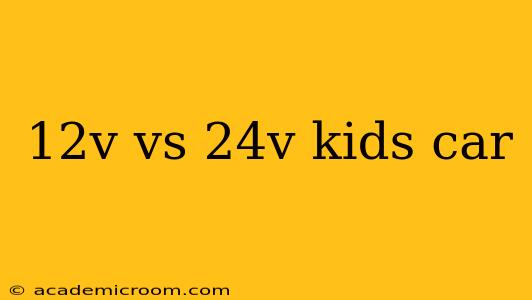12V vs 24V Kids Cars: Which is Right for Your Child?
Choosing between a 12V and a 24V kids' car can be confusing. Both offer the fun of driving, but the voltage difference significantly impacts performance and suitability for different age groups and situations. This guide will help you understand the key differences and choose the best option for your child.
What's the Difference Between 12V and 24V Kids' Cars?
The core difference lies in the power source: 12V vehicles use a single 12-volt battery, while 24V vehicles use two 12-volt batteries connected in series. This doubles the voltage, resulting in a considerable difference in power and performance.
12V Kids' Cars:
- Lower Power: These are typically suitable for younger children (ages 2-5, depending on the child's size and development). They offer a gentler driving experience, ideal for learning the basics of driving and control.
- Slower Speed: Expect lower top speeds compared to 24V models. This is a safety feature for younger, less coordinated drivers.
- Simpler Features: Often equipped with fewer features and accessories than 24V models.
- More Affordable: Generally less expensive to purchase and maintain.
24V Kids' Cars:
- Higher Power: Designed for older children (ages 5-8, or older, again depending on the child's size and maturity). The increased power provides a more powerful driving experience.
- Faster Speed: Significantly faster top speeds than 12V models. This requires a greater level of coordination and responsibility.
- More Advanced Features: Often include more advanced features like more powerful motors, improved suspension, MP3 players, and even parental remote controls.
- More Expensive: Higher initial purchase price and potentially higher maintenance costs due to more complex components.
What Age is Appropriate for Each Voltage?
This is a common question, and the answer isn't one-size-fits-all. It depends on your child's maturity and physical abilities.
- 12V: Generally suitable for younger children, typically aged 2-5. However, always supervise young children closely, regardless of the voltage.
- 24V: Usually recommended for older children aged 5-8, or even older, depending on size and developmental stage. The increased speed and power require more coordination and responsibility. Adult supervision is still crucial.
What are the Safety Considerations?
Safety is paramount. Regardless of voltage, always supervise your child while they are operating the vehicle. Choose a model with safety features like a seat belt and working brakes. Consider the terrain where the car will be used – a smoother surface is preferable for younger children.
Which is Better for My Child?
The best choice depends on your child's age, size, and maturity level. Consider these factors:
- Your child's age and development: Younger children benefit from the gentler power of a 12V car, while older children will enjoy the greater power and speed of a 24V vehicle.
- Your child's driving skills: A child who lacks coordination might be better suited to a slower 12V car.
- Your budget: 24V cars are generally more expensive than 12V cars.
- The intended use: Consider the terrain and environment where the car will be used.
How Long Do the Batteries Last?
Battery life varies depending on usage and the quality of the battery. Both 12V and 24V batteries will eventually need replacing. Generally, you can expect several hours of playtime on a single charge, but this can be significantly shorter if the vehicle is frequently used at full power.
Are 24V Cars Too Powerful for Younger Children?
Yes, they can be. The increased speed and power can be overwhelming and potentially dangerous for younger or less coordinated children. Prioritize safety and choose a vehicle appropriate for your child's developmental stage.
By carefully considering these factors, you can choose the right kids' car for your child, ensuring many hours of safe and enjoyable playtime. Remember that adult supervision is always recommended, regardless of the vehicle's voltage.
